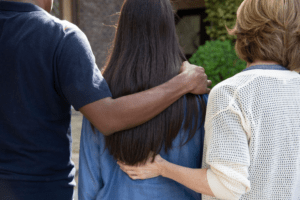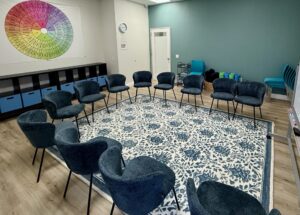Over the past two years, we’ve published four articles on the role sleep plays in the lives of adolescents.
One article was about sleep in a second-hand way. We talked about the impact of school start times on academic performance among teenagers in Seattle. Later start times meant more sleep, which translated into better graders for the teens.
Read that article here: Delayed High School Start Times in Seattle: Positive Outcomes.
The next three were about the relationship between sleep and mental health. We discussed the general impact of sleep on mental health, then dove deeper and examined how sleep can affect the symptoms of ADHD, and finally addressed the connection between sleep and anxiety.
Click the titles below to read those articles:
Teens, Sleep Habits, and Mental Health: What’s the Connection?
Sleep and Anxiety: The Connection
Here’s a brief summary of the content of those articles:
- The research team who conducted the sleep habits study found that teens who went to bed late and got up early – many of whom had insomnia – had poorer mental health overall than their well-rested peers, and were also at increased risk of developing emotional, behavioral, or other mental health issues.
- The study on sleep and ADHD showed that teens who slept nine and a half hours or more per night outperformed teens who slept six and a half hours or less per night one tests that measured working memory, emotional control, impulse control, and planning/organizational skills.
- The study on sleep and anxiety came to a simple conclusion: “A lack of sleep amplifies anxiety in a dose-response manner.” That means exactly what you think it mean: less sleep, more anxiety.
The long and short of this research is straightforward: adequate sleep helps teens who live with mental health disorders.
What Helps Teens Sleep?
Many years ago we heard an experienced educator offer this advice about how to structure a full day with adolescents. This particular person worked in outdoor education, but we believe the idea applies to adolescents in almost all situations:
Get them up early, run them hard all day,
then after dinner all they’ll want to do is fall asleep.
We like that approach.
But since we’re committed to using only evidence-based techniques and approaches to treatment for teens, we decided to see if we could find any data on the relationship between exercise and sleep in adolescents.
We admit, it seems like a no-brainer: if you work out, you’ll be more tired than if you didn’t. And if you’re more tired, you’re more likely to fall asleep. Therefore, working out, i.e. exercise, leads to more sleep.
That might be the most basic logical syllogism you’ll ever find.
It’s logical, yes – but is it backed by real data arrived at through our trusted friend, The Scientific Method?
A study published this year in Nature magazine has the answer.
Exercise Helps Teens Sleep
Okay, busted: we gave away the conclusion of this entire article in that one heading.
That’s okay, though, because the details of the data are interesting, and we bet you knew the results anyway.
Now, for those details.
The study looked at the exercise and sleep patterns of a total of 417 students from diverse backgrounds over the course of a year.
Here’s what they found:
- On days when teens were more physically active than usual, they went to sleep earlier and slept longer.
- On days when teens were less physically active than usual, they went to sleep later and didn’t sleep as long.
Let’s back up and clarify something: when measuring physical activity, the type of activity that counted was moderate-to-vigorous physical activity, which researchers labeled MVPA. You need to know that before reading this next set of results:
- For each additional hour of MVPA, teens fell asleep about twenty minutes earlier and slept for about ten minutes longer.
- When adolescents participated in MVPA earlier in the day than usual, they fell asleep earlier that night.
- Adolescents who engaged in MVPA than average reported better sleep quality than adolescents who did not engage in more MVPA than average.
There you have it: the results of this study clearly indicate that increased MVPA leads to an increase in both sleep time and sleep quality. When we combine those results with the information in our three previous articles on sleep and adolescent mental health, we can connect the dots and arrive at this conclusion: exercise is beneficial for adolescent mental health.
Why?
Because it helps them get the sleep they need.
There are more reasons than that, of course, but the direct effect of exercise on adolescent mental health is a topic for another article.
There is an outstanding question to answer here, though: how much exercise?
Exercise for Adolescents: An Hour A Day
The Centers for Disease Control (CDC) indicate that adolescents should get at least one hour (60 minutes) of moderate-to-vigorous physical activity per day to promote short- and long-term wellness. These sixty minutes should include:
- Aerobic Exercise. Think walking, jogging, cycling, or group classes with cardio in the name.
- Muscle-Strengthening Exercise. Think free weights, weight machines, or body weight exercises like pushups and sit-ups.
- Bone-Strengthening Exercise. Any activity that produces a force on the bones will stimulate bone growth, density, and overall strength. This usually involves impact with the ground, such as occurs in running, jumping, and playing sports like basketball, tennis, or anything that involves running and jumping.
That’s the exercise our adolescents need: an hour a day, mixing in the three types of exercise listed above.
And what about sleep? Because that’s really the point of our discussion: sleep improves mental health, exercise improves sleep, so how much sleep should teens get each night?
For optimal health, the CDC says teens need 8-10 hours of sleep per night. The CDC also says that on an average school night in the U.S., 72.7% of teens do not get enough sleep: yes, that’s 7/10. Seven out of ten. Well over half. Or, more simply put:
Most teens out there are not getting enough sleep.
The good news is we know how to take steps fix that: increase the amount of exercise teens get each day. It may not be an easy fix, especially if sedentary lifestyle habits are firmly entrenched, but it is a very real and achievable fix, which can be implemented right away.






























































